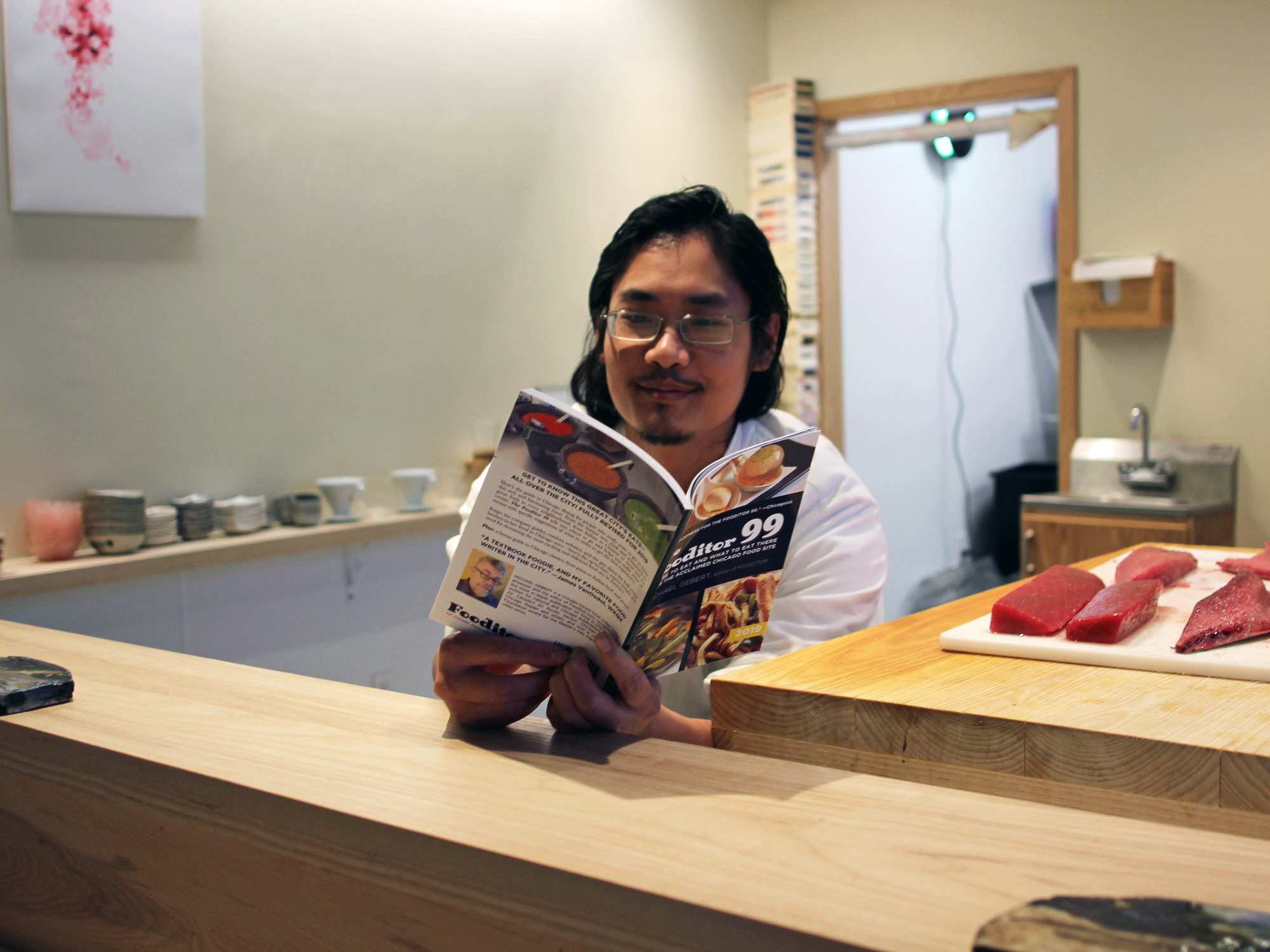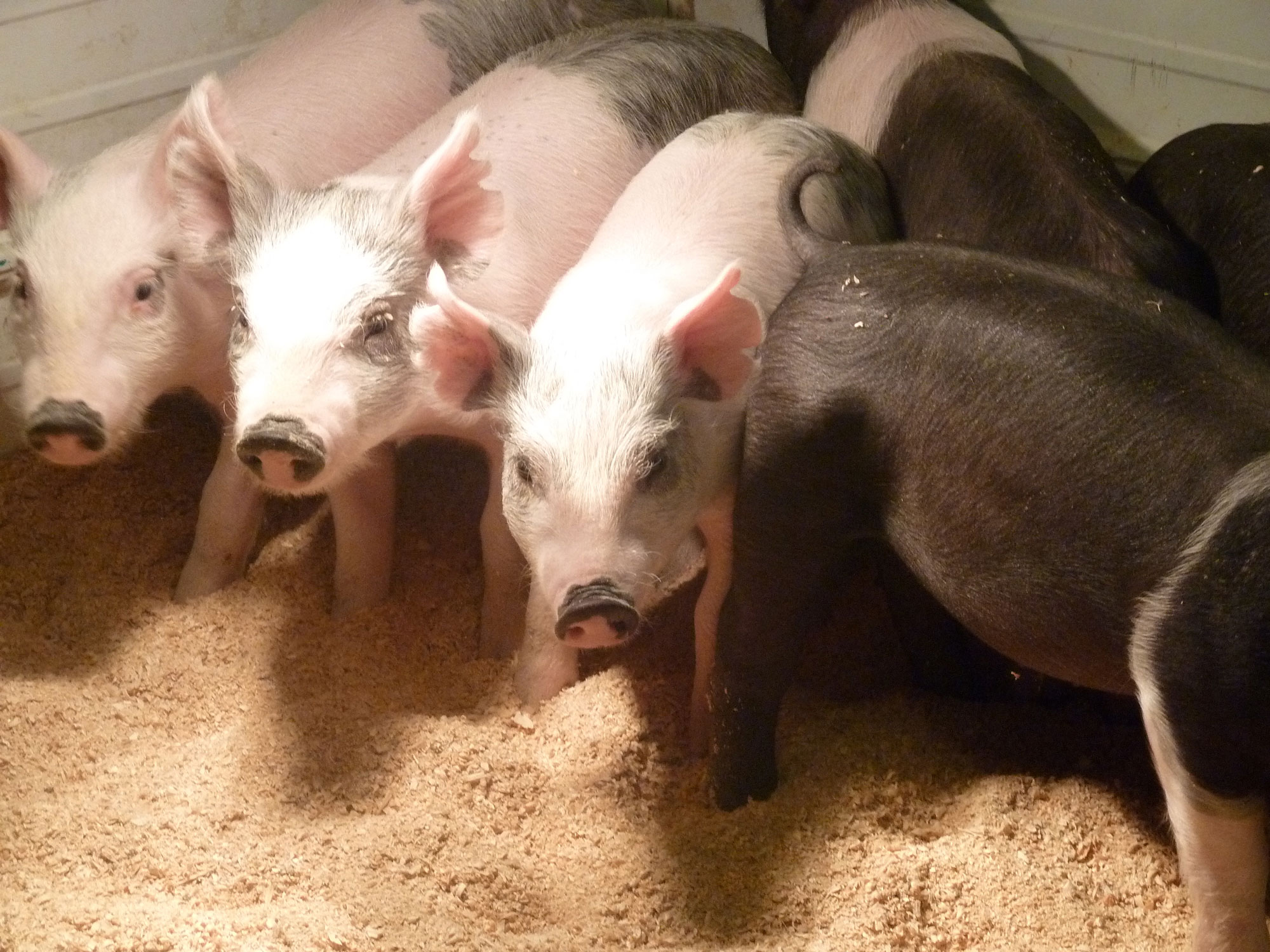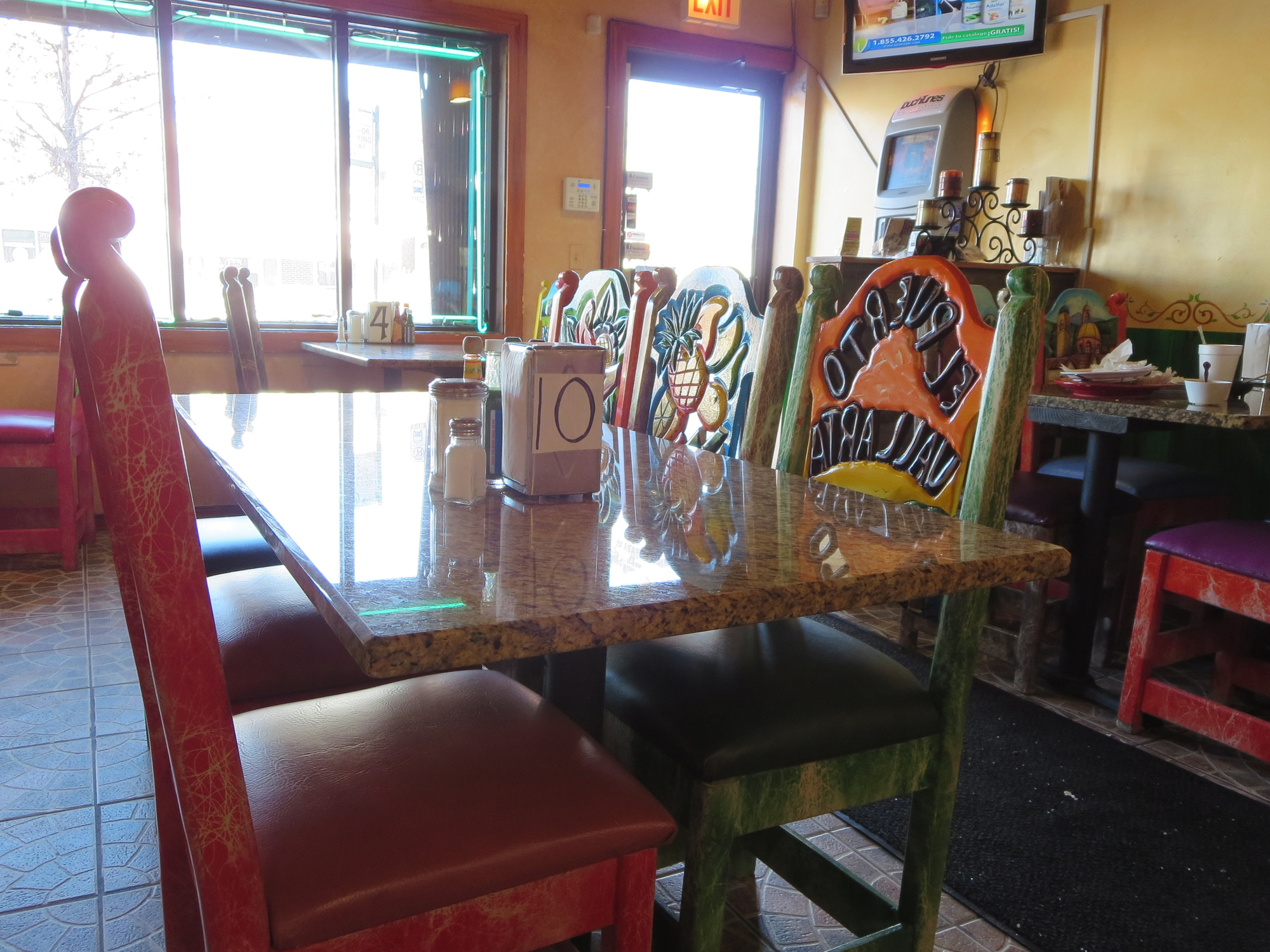I SEE HIM OFF IN THE DISTANCE, an older man in cowboy boots, cowboy hat and leather jacket, loping with weary bones toward us across the barren, dusty asphalt. He enters and greets the cook behind the counter. They speak for a few minutes in Spanish; then the cook hands him a paper bag and he walks to the cash register to pay. A moment later, he’s heading off in the distance of the parking lot.
“He comes in here every day for tamales,” said David Rodriguez, the husky young cook behind the counter. “We get a lot of the neighborhood in here, they’re happy about us being here. There’s a Polish lady, Cathy, who comes in every morning, about six a.m., to drink her coffee. She always asks us if there’s anything she can do to help. If she can wash the windows or something.”

David Rodriguez and amigo
We’re on the southwest side of Chicago; a few more blocks on Archer and you’d be right at Midway… or at least its economy parking garage. If your idea of an old school Chicago neighborhood is three-flats and bungalows, we’re a little south and west of that—this is more like the buff-colored 70s sprawl that could be on any interstate in America. But Mexicans know how to make a neighborhood out of any urban setting, and bright and sunny Xocome Antojeria, open only since June, seems to have won hearts quickly with its freshly made, exuberantly oversized Mexican plates—especially the house specialty, the tlacoyo, which could teach deep dish pizza something about piling it on.
I’m there a little before lunchtime, and Rodriguez is working behind the counter on a big platter of carnitas, which he simmers in a mixture that includes, for the requisite touch of sweetness, orange soda. “One of the old Mexican cooks around here, he asked me what I put in it, and I told him, orange soda pop. And it was like he didn’t want to talk to me any more,” Rodriguez laughs. He fishes out a nice hunk of the meat that looks tender enough by now, and plops it on a plate for me to try. The juicy pork has the tiniest hint of citrus, along with some deep spicy heat; it’s a hearty second breakfast for me. I would not stop speaking to him over it.
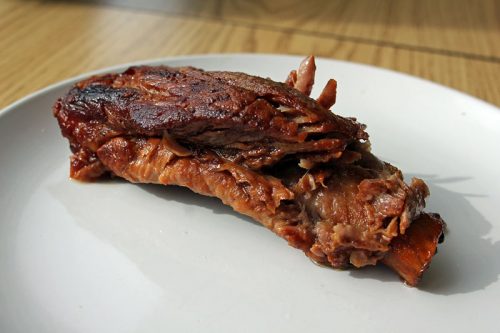
Pork rib carnitas
Further down the counter, which is decorated with chalk-written sayings (almost all in English: “Keep Calm and Eat @ Xocome”), his wife Sarah Mendoza and another employee are mixing masa and making tamales for the day. You can see everything going on in the restaurant over the counter (even if you can barely see Mendoza over it—her husband towers over her). Which was part of the idea for the restaurant. It turns out that for a guy with a restaurant way down on Archer, Rodriguez has worked at pretty high levels in a surprising number of restaurants you have heard of. This is, deliberately, kind of their opposite.
“I enjoy this very much, because I get to cook every day, and it’s really cool to get to talk to people while I cook. I get to be with my wife and my family, and to me that’s everything,” he explains from his side of the counter to me. “When I helped run those other restaurants, when I ran the kitchen—I didn’t so much enjoy that. The numbers and the paperwork—I understand that it’s a business and all, but I didn’t genuinely enjoy the process. I enjoy the parts that involve cooking, and feeding people, and watching peoples’ reactions when they eat—that’s why I like to cook.”
He offers to make me a breakfast taco, and when I say yes (of course), he motions to his wife to start making a blue corn tortilla from the tub of masa, pressing it in the press and placing it on the grill. “My mom’s the same way—she really enjoys the part of feeding people. You hear them say ‘Oh, this is really good,’ and we get to talk about it—why we do the things we do and where it came from.”
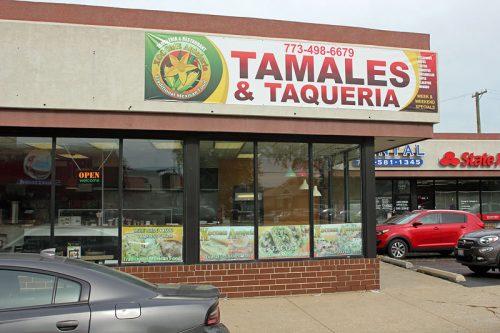
WE’RE WAITING FOR HIS MOM, Bertha Montes Garcia, and he tells me that she’s the reason, more than he is, why the restaurant exists. “My mom, one day, she says she’s tired of working at the bank. She says, you really like cooking, I like cooking, let’s do something.”
“I kind of tried to talk her out of it,” he smiles. “‘Mom, it’s not glamorous, it’s not fun. It sucks.’ But she was like, no, I’m gonna do it.” Her husband had built this little corner property on the edge of a strip mall, which had been a bakery outlet—the only piece of installed equipment in the place a sink. Now, with some help from buddies in construction, he fixed the interior up into a restaurant, with the open kitchen and its counter, and tables lining all the windows.
Rodriguez himself has been cooking about ten or eleven years—he’s 32 now—starting as one of the countless Mexican-American kids in the backs of kitchens all over Chicago. GT Fish & Oyster is where he says he first got the idea that cooking might be, not a passing paycheck, but a career.
“I would just see these really good line cooks, these amazing line cooks, and wonder if I’m ever going to be able to cook next to that guy, be as good as they are. How does that guy do it?” he says. “I never really thought about what the next step was. I would always show up an hour or two early, make sure my things were set up and we were good for service. Because if you work next to these guys, that pushes you, that motivates you for excellence.”
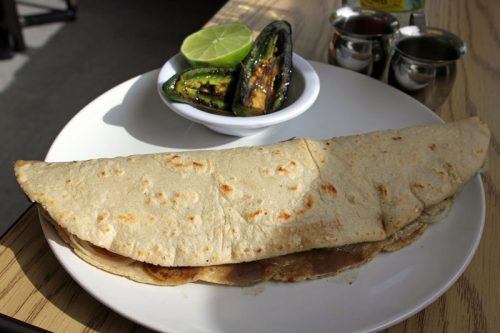
Quesadilla
GT’s then-sous chef, Jessica Carney, now at The Restaurant at Meadowood in Napa Valley, was the one he says noticed and encouraged his drive and interest in improving. “Honestly, I was afraid of Giuseppe [Tentori] and afraid of Jessica, not because of what they did, they were always very nice, but because they seemed so skilled,” he says. He started staging around in both Chicago and San Francisco, and rose through the kind of positions that give you titles and experience if not much notice in food media—he was chef-de-cuisine at Luxbar, an executive sous chef for the Standard Group (grocer and restaurants in the western suburbs), and he worked for the first chef of The Kennison, Bill Walker. (Which is where he did get his first bit of media exposure—you can see him in Walker’s Key Ingredient episode.)
By now his mom has come in, and she explains where the idea for the restaurant came from. Unlike her son, she had never worked in restaurants—well, except when she was a kid from a farm town outside Mexico City. “Saturday and Sunday my aunt, we used to take the metro in Mexico City to Tlateloco, which is the real Mexico City in the middle of the city,” she says. “And I was helping her, and she was selling tlacoyos, quesadillas, that was how I learned to do that.”
The other Mexican cooks kind of saw me as one of them, and they kind of didn’t. It’s a kind of segregation, just culturally-wise—’He’s a guero.’
That was how she learned to make them, but she only ever made them for her family; after coming to America at age 17, she worked for a succession of banks on the southwest side, including 16 years for Bank of America. “My son was involved in restaurants, and in my heart, I’m thinking, why not start something where he can start making his own future for all of us,” she says.
David’s reaction was that if they were going to do it, “What would be cool would be doing something that speaks to what she made for us, what we grew up eating. Something she could execute and I could execute. The traditional stuff—the taco, the tortas, the burrito, quesadillas,” and most of all, her tlacoyos.
Though his mom now lived and worked on the southwest side, David had grown up near Bryn Mawr and Sheridan, and lived in Uptown most of this time—giving him a wider perspective on food. “I love ramen, I love pho. The food is so different, there and here—it’s amazing. Super diverse. Here, it’s very Hispanic driven,” he explains.

Bertha shows off a blue corn tortilla
He had ideas about how to make a casual Mexican restaurant that would stand out in an area where they’re common. One thing, for instance, was offering filet mignon tacos, for a premium price (about $5, vs. for $2 for a standard taco) that seems insanely cheap by any other cuisine’s standard. “She said it was too expensive. I said, if we’re going to do them, we’re going to do quality,” he says. On weekends, he makes soups in the classic way, the traditional weekend menudo plus whatever else he feels like—a shrimp caldo, caldo de chamorro (beef shank). Not long ago a forager brought him maitake mushrooms, and he made a special out of that.
But the main thing they agreed on was that everything should be freshly made, from scratch. Bertha says, “Before I opened, I was always thinking to offer what they make on the street, but inside. Fresh, like quesadillas. I do believe that rice has to be made daily, salsas have to be made every other day at least. If you want to eat a taco, that’s how I want to make it, homemade, fresh. If I’m going to eat two tacos, they’re going to be with real tortillas, fresh in the moment.”
“We didn’t want to just slap it on a plate and run,” David says.
The other thing he knew they were offering, was his mom’s open, welcoming personality. “I don’t know how she does it. It’s just the way she is, it’s who she is. People feel comfortable with her.”
She’s a big warm tlacoyo piled high with beans and stuff, I suggest. “She is! That’s my mom’s personality,” he laughs. “She’s a huge personality. She doesn’t think about it, but she is.”
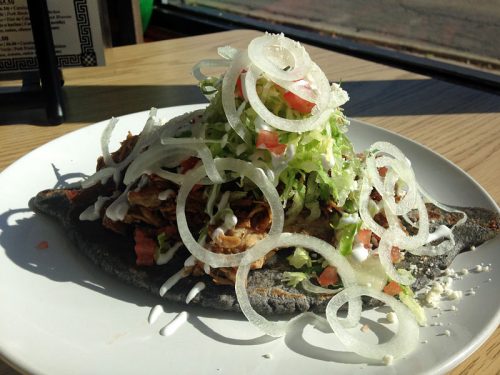
Tlacoyo with carnitas
THE TLACOYO STARTS WITH BLUE CORN MASA, into which black beans are worked. Ideally, its shape is an oval, with the shape sort of like a nipple at each end—trying to think of something else with that shape, all I can think of is the Georgian baked egg pastry hachapuri. Then, typically, it’s topped with some kind of meat, steak or carnitas, then lettuce, tomato, onion and crumbled cheese. The final result is less ovoid than pyramidesque.
It’s the one thing in the place David won’t make. “I can’t do them. Mine are like deformed continent-looking things.”
He left his job at The Kennison to open Xocome, but getting the proper licenses and inspections took longer than expected, and in the meantime he took a job at Maya Del Sol, a nice sitdown Mexican restaurant in Oak Park. Ten years old, it was looking for someone to refresh its menu.
“Maya was fun, just being in a whole other city. I never really been to Oak Park, Oak Park is cool,” David says. “One of the things that really made me do it was that they told me I had creative freedom. You can tell the guy that you want to be your chef, we’re going to pay you enough money to live and to get here and back from home—and we’ll give you creative freedom over the menu. And you’re gonna take that job.”
He muses, “At Luxbar they gave me a lot of freedom to write stuff, but then it’d get too Mexican and they’d be like, David, chill out. Go write some gastro stuff. In the moment it can be discouraging, but you don’t realize how much it makes you grow.”
He’s proud of what he accomplished at Maya Del Sol: “People were really set, I pushed them to try new things—not to the point where they’re eating crickets. But people really took to what I was doing.” While there, he also met Mendoza, now his wife and co-worker.
David’s tale of his rise in Chicago kitchens puts me in mind of something we mostly overlook—the heavily Mexican workforce behind a lot of mostly white chefs. Most of them are not tapped on the shoulder to move up, as David was. One key difference is that he’s not Mexican—he’s Mexican-American, born here. I ask him if he felt his bosses perceived him differently because he was a native English speaker.
“Oh, yeah, automatically, unfortunately,” he says. “I think some of those guys who are in the kitchen chopping stuff—it’s not that they don’t want to be chefs, they just don’t have the confidence, it’s the lack of communication. I met guys in those kitchens who have been in a place for 10 or 15 years, and they never give them a shot to move up.”
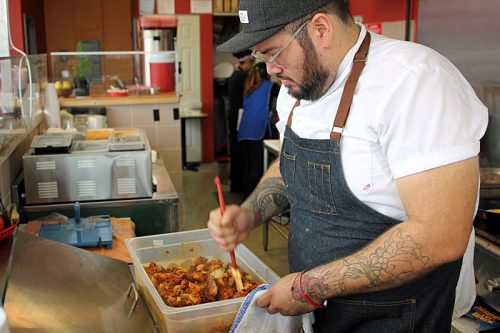
“So when I came along, [the other Mexican cooks] kind of saw me as one of them, and they kind of didn’t. It’s a kind of segregation, just culturally-wise—’He’s a guero’ [“paleface,” a U.S. resident]. I heard that a lot about myself. There’s this whole macho thing, which I really hate, from the line cooks—the guys who are going to be working the same position their whole lives, they have no ambition to move up. It was very much like high school—you have the kids who are very studious, and then the bullies,” he says.
I suggest that it’s like the pressure on kids in some African-American communities not to “act white.” He says “All communities. ‘Why you wanna be white?’—I hate that stereotype, just because you’re trying to be educated, and well-spoken. I speak proper English, and I respect people, their beliefs and culture, and what they do. I found that a lot in my career.”
Still, he draws back from faulting the companies he worked for for a kitchen culture that seems to develop on its own. “I think it comes down to you wanting it,” he says. “Like, I’d hear the chef tell the sous chef, tomorrow we’re going to butcher fish, and I’d ask if I could come in and they’d be like, yeah, of course. And then when I became a chef, those are the guys that I’d pull [into support positions], because that’s how I became a chef. Those are the types of guys who are going to help you run the place, make it a successful place.”
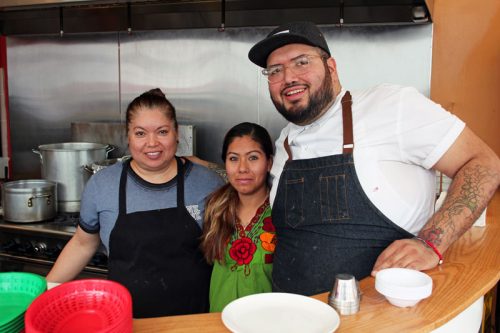
Bertha, Sarah and David
BERTHA FINALLY CALLED DAVID ONE DAY and said, “I’m opening it.” “I tried to help her, guide her, I was working at Maya and I came in whenever I could to try to help her. Finally, a couple of weeks in, I gave my notice and said, okay, let’s do it.”
It almost ended before it began—Bertha had cashed in her 401k for operating capital after the first few weeks, and the check didn’t clear before a weekend. “We didn’t have any money for meat for the weekend. I went to people and begged them to lend me money so we wouldn’t have to close right after we opened.” Fortunately, business grew quickly and that hasn’t happened again. They feel the neighborhood has embraced them—and after Titus Ruscitti wrote about them on his blog, they’ve had a steady drip of press attention (see also the current Chicago magazine, no link yet).
“To me the south side of Chicago, food wise—food will tell you a lot of things,” David says. “Like, people are really starting to become more diverse around here. More open-minded, it doesn’t feel like that stigma of the south side being like, very rugged and fringy.”
At one point, in the midst of simmering a big pot of carnitas, or maybe making me a steak quesadilla, he goes into a kind of reverie, that suggests a man who’s happy with where his life, and his mom, has taken him.
“Some days we’re cooking here, when it gets packed—I mean, it’s not that big, so right now it’s kind of packed and it’s just us. But you see people are wrapped around the corner waiting, and people are sitting down, families, there was a guy from Southwest Airlines, a white guy, over there, and this table, an African-American guy. And this table was two women born and raised here, one was going to work dressed like some kind of nurse, maybe the other was her sister and she has a baby. And then this table, it’s an older couple. But they’re all eating tamales, drinking champurrado, this guy’s eating a steak taco at like eight in the morning, and the other guy’s eating a tlayoco, and they’re eating chilaquiles, and the vibe is really cool.”
“And I’m able to talk to all of them, how are you doing, what do you need. I like it. I enjoy it.”
Xocome Antojeria is one of the restaurants in The Fooditor 99, available now. Go here to order in paperback, or here for Kindle (which allows you to read it on cell phones and tablets via Kindle software).
Michael Gebert is the big tlacoyo of Fooditor.
Latest
Join the Discussion
After you comment, click Post. If you're not already logged in you will be asked to log in or register with Disqus.





